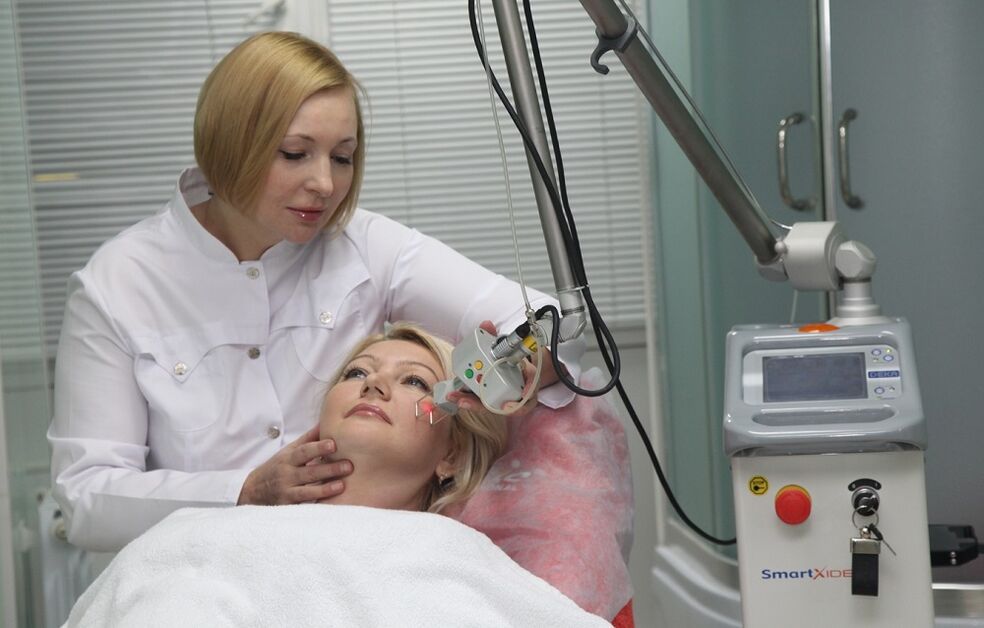Every woman wants to be the owner of perfectly smooth and young skin without a single wrinkle. Over the years, the aging process of the skin becomes more and more active, so that it quickly loses its elasticity and firmness. Fractional laser rejuvenation helps restore skin quality. The effect of heat during the procedure activates cell growth, ensures the production of collagen fibers and the removal of the dead skin layer.
operating principle
Partial rejuvenation with laser - what is it? Experts therefore speak of skin renewal with high temperatures provided by a laser beam. The principle of operation of the technique is similar to laser resurfacing, but it has a deeper effect and potentially complex consequences. The device for the procedure is small and equipped with photocells that ensure the penetration of the laser beam into the tissue. The specialist moves the device very quickly over the patient's skin, otherwise burns may occur.
types
Specialists distinguish between ablative and non-ablative types of fractional laser rejuvenation. Ideally, a combination of both types of exposure is recommended.
ablative type
A non-surgical facelift with an ablative type helps resurface the dead layer of skin cells. This option allows you to get rid of the first signs of aging. The procedure affecting the skin activates the growth of healthy new cells, tightens, evens the skin tone, smoothes expression lines.
non-ablative type
A non-ablative type of laser rejuvenation is used for irreversible skin changes. This option allows you to affect the deep layers, eliminate pathological processes in the skin, promote cell regeneration and the formation of a membrane framework, activate the production of collagen fibers.
Hints
- flaccidity, sagging skin;
- The presence of pigmentation, acne, enlarged pores;
- The presence of scars, rosacea (spider veins), striae (stretch marks);
- The presence of facial wrinkles, "crow's feet" around the eyes.
contraindications
Experts advise against laser rejuvenation in the following cases:
- The presence of allergic reactions, skin infections;
- The presence of inflammation in the area of \u200b\u200bthe planned impact, psoriasis;
- Epilepsy;
- The presence of malignant tumors in the area of \u200b\u200bthe planned impact.
preparation time
Before fractional rejuvenation, the following must be stopped:
- An antibiotic treatment based on tetracyclines;
- Use of cosmetics containing alcohol;
- Visiting beaches, solariums (refusing to sunbathe a few weeks before the procedure).
How is it done

All manipulations as part of laser rejuvenation are performed under local anesthesia. During the procedure, the patient may experience some discomfort. The whole process takes about half an hour.
During the operation of the device, special protective goggles are placed in front of the patient's eyes. Remember: the level of exposure and intensity of the procedure is selected by a specialist individually for each patient. The course mainly consists of 7 sessions. This is enough to smooth even deep scars and get rid of most wrinkles.
effects
Immediately after fractional rejuvenation, the patient feels pain even when taking painkillers and medicines. After about 3 hours, the skin reddens and swells a little (swelling is at its maximum on the 2nd day), especially around the nose, around the eyes and on the upper eyelids. To reduce swelling, you need to drink diuretics and reduce the amount of salty food.
On the second day there is a copious secretion of secretions and the appearance of a crust on the face, which hardens towards the end of the day (it is forbidden to touch it and try to remove it), fraught with infections and the appearance of scars). After a while, it will soften and go away on its own (this is where the use of skin regeneration products will help).
After about a week, swelling on the face stops, but a pronounced pink tint on the skin persists for about a month. When going outside, the use of compounds with a sun protection factor (at least SPF 30) is required, taking vitamins is recommended. Sunbathing, as well as the use of peelings (peeling, peeling, gommage) is prohibited.
Usually, after 3-6 months, the specialist prescribes a second session, and all the consequences have to be transferred again.


























